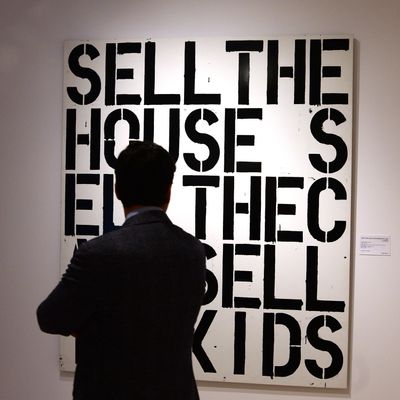
Tonight, sometime after 7 p.m., Christopher Wool’s signature 1988 work, Apocalypse Now, will be auctioned at Christie’s, and estimates for the selling price are in the $10 to 15 million range; the last week or so has seen similarly record-high contemporary art purchases. Instead of catering to carefully selected museums and collectors, auction houses sell to the highest bidder. They find two people who want the same work and get them to bid as high as possible; often those who buy work will only sell it again in two years.
This is capitalism at work. And I’m a capitalist. Yet, the collections being auctioned off lot-by-lot have occasionally been assembled over the course of lifetimes, a lifetime, or decades. It is the seller’s right to sell art this way, but collections split up like this will likely never come together again. The larger idea of what “a collection” is evaporates. Most work sold this way will rarely ever be seen in public again in our lifetimes.
Many may dislike Wool’s art, yet Apocalypse Now is arguably his most important single painting, a highly influential work. By picking this exact moment to sell this painting, the seller is distracting from Wool’s current Guggenheim retrospective and creating a circuslike atmosphere around his art, shifting discussion from art to money, while exploiting the market as much as possible. Couldn’t this seller at least have waited until after this survey is over, cashing in on Wool’s success in eight months? Or, couldn’t auction houses, in these rare examples, work with the seller and make the case to allow the Guggenheim to put together a couple of millionaire trustees who might buy the work for slightly less than it is estimated at and donate it to the museum? No museum can otherwise afford the prices that auction houses command. It would be a win-win situation: The seller gets the tax break and still rakes in almost $10 million, and the work goes on view to the public. Good or bad, the painting is out of play, in a museum collection. But the way that auction houses now operate, the only winners are often one of the four megadealers or a handful of other high-rollers and blue-chip dealers who buy the work and resell it for more.
I am partly touchy today because this imminent sale means that Wool’s Apocalypse Now is probably about to disappear for some time, and I’m a fan. But I’m also depressed by the mass e-mail I received yesterday from Christie’s Chairman and International Head of Post-War and Contemporary Art, Brett Gorvy, giddily and carelessly hyping sales: Referring to this weekend’s Christie’s sales preview and events he wrote, “What a weekend!”, the sales galleries were “packed with record attendance … Who could have guessed that an early De Kooning could feel so contemporary and vital and hold its own?” I thought, “Every art-interested person alive could guess that.” What really got to me was when he opined that it was “wonderful to watch so many people having their photos taken with the work…It seems such a shame that an exhibition of so many great works will have to be dismantled tomorrow … Many museums would dream to be able to have a show like this for even six months yet we had barely five days to enjoy this.”
Tragically, he’s right. Museums can’t afford to buy the best of this art anymore. They can barely afford to mount large shows of it, let alone move it all in and out the doors in five days. Auction houses are wrong if they think that what they’re organizing are “exhibitions”: These are highly promoted sales events, ways to cajole collectors, soothe anxious buyers and sellers, and maximize profits.
Gorvy wrote of the “many records” that will be set tonight, adding, “In my heart I believe the results will be extraordinary … records will be achieved.” And so they probably will. Auction houses constantly talk about how auctions are about “quality.” They’re not. Not really. As I’ve written before, “auctions are altars to the disconnect between the inner life of art and outer life of consumption, places where artists are cut off from their art. Auctions have nothing to do with quality. At auctions, new values are assigned; desire is fetishized. Consumption becomes a sort of sacrament, art plays the role of sacrificial lamb and the Ponzi scheme that surrounds it all rolls on.”
By this time tomorrow, a handful of really great works will probably never be seen in public again. Or at least not until they come up for sale again.

